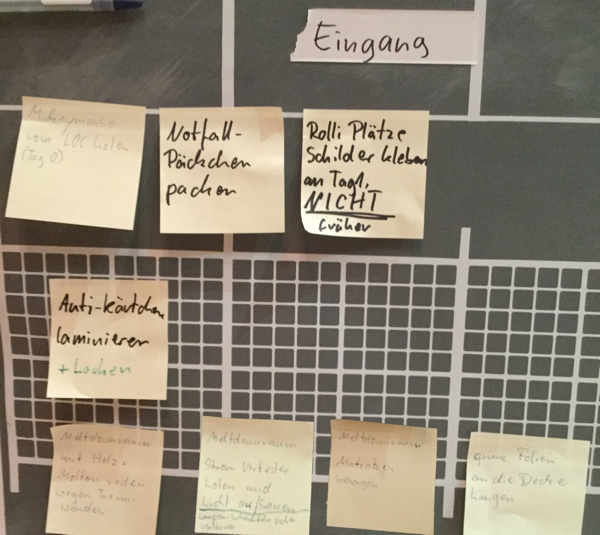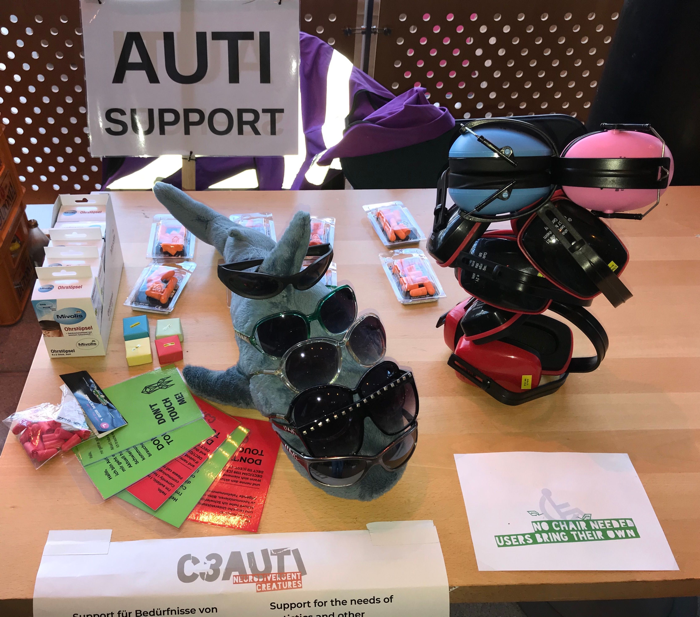About
Disclaimer: I’m speaking from my perspective here, but let’s keep in mind that such group activities are always a group effort.
c3auti
is a volunteer organisation that cares for the needs of autistic
people at events of the Chaos Computer Club.
When I first heard of it, I laughed, because: maybe a third of the
people at Chaos events show autistic traits, and suddenly we need a
committee for that? But it turns out we do need one, we need it
because as an institution c3auti can talk to other institutions and
can for instance run the QuietQube.
In August 2019 fairsein recruited me for c3auti for the Chaos Communication Camp, and as I was looking for a new team anyway, I joined. It was chaotic and enjoyable, and there were organisational challenges that spurned my ambition and my lust for improving organisational things.
At Camp
Previously I had been mostly unfamiliar with autism and during Camp I had my first experiences with helping autistics in stressful situations. My way of approaching this was treating them like people who got stuck on a bad trip in hypnosis, using simplified language and assuming them to have normal needs but being limited in language and rational thinking. Searching for connections between hypnosis and autism I couldn’t find any, but practically that approach was successful, I got good feedback.
Other people who worked at c3auti had different approaches, this was interesting to see. We recognize it when we see it, but explaining how to care for someone well is hard.
On the management side my contributions were little, like writing
meeting protocols.
Until Camp 2019, one had to be autistic to have a leading role at
c3auti and I found that problematic for two reasons: I think we should
not force people to out themselves and diversity in a team is always
good, it is good having neurotypical people in responsible roles too.
I helped ease the way into having non-autistics at c3auti.
Congress planning
When the 36th Chaos Communication Congress drew nearer, I became a team lead at c3auti. Things that were brought forward through me were doing the QuietQube, writing better documentation, organizing things early enough and changing the staffing structure.
Documentation
In short, I did my best to have good meeting protocols and other written material, like a shift schedule, so future people who do c3auti at congress have something to start from and don't need to reinvent everything every year. I knew, and made public before congress, that I won't stay at c3auti forever, and therefore making an effort to involve future activists was important.
Staffing
A troublesome aspect at camp was the team role 'coordinator',
because it wasn't well defined what they have to coordinate at all,
different people understood their job differently. If one would have
done the sum of everyones opinion, that would have been superhuman.
For Congress I ended up splitting the job in two: a management
person who would moderate meetings, make sure everyone can work well
and onboards new team members, and a specialist for emergencies
(coordinating emergency missions).
I'd recommend that separation for events larger than 3000 people, at
small events there just aren't enough qualified volunteers for both
roles.
The QuietQube
Origin of the concept: better inclusion
Yes, my aspiration for inclusion is high, lets aim for 300% and
achieve 150%.
A thing that bugged me at camp was the exclusionary nature of the
c3auti infrastructure. On the one hand people at c3auti were
encouraged not to ask for diagnosis but on the other hand the room was
'for autistics', therefore using it required the awareness of ones own
neurodivergence and would out oneself. Can't we have something like
the hackcenter, a general hacking and socializing area, that works
well for autistics, so they can participate in the congress equally
well as neurotypical people and don't need the meltdown room as often?
This is what the QuietQube was.
In order to not ask for diagnosis at all, the QuietQube was
defined/described by rules instead of 'for autistics'.
We declared the rules as following:
- no music
- blinking has to be limited to the most necessary, no photo flashes
- mild light that does not dazzle
- no booths of organizations like Digitalcourage (only booth: c3auti, with the Auti cards + information)
- no loud political demonstrations (e.g. Extinction Rebellion)
- no loud art (e.g. choir)
- conversations are allowed, but (bigger) workshops and meetings are not allowed
Planning and build-up
As the location, we got a cube-shaped restaurant, hence the name.
Fun fact: in order to discuss with
Fhainalex what is going
to be where, I made a QuietQube doll's house.

We got great support from the c3LOC, and so c3auti could run such a large place at congress for the first time, with mostly first-time team leads.

During Congress
Chaos magic emerged, with all its diversity and beauty. With the accessibility issues out of the way, autistics are quite wonderful, and that showed.
One task that made it into an institution during congress were the 'Sssh Angels', who told people, who left lecture hall Adams, to be quiet above the QuietQube.
With workshops and meetings being forbidden at the QuietQube, we had our meetings and workshops elsewhere. The meeting 'Autismus Nerdtalk', which was a Lean Coffee structured event about autism topics, became a series, and can be found in the self-organized session list of DiVOC.
The collaboration with Chaos West went very well, we attended their soundcheck to make sure that their stage isn't noisy in the meltdown room, and that night they had their party we moved the meltdown room into a different room.
c3auti made further educating content for non-autistics, for instace I gave a lightning talk about accessibility for autistics at larger events.
c3auti gave sun glasses and hearing protectors to people who needed it, particularly at the party night.

Conclusions
Words and concepts are not my greatest talent and not everyone could imagine before 36c3 what the QuietQube would be like. But when they saw it things fell in place and now one would rather have to justify not making it again than making it again.
Since the environment was problem-free-er than congress usually is, it made neurodivergent people problem-free-er and we could get to know each other better in our strengths and not only in our inadequacies.
Apart from not needing to out one-self another burden was taken away from the people who used the QuietQube: the necessity to explain special needs, which people in marginalised groups generally have, and which is one of the big problems of belonging to a marginalised group.
They might not be aware of it, but neurotypical people get overwhelmed at congress too, particularly the more introverted ones. The QuietQube was supposed to be for everyone who appreciate the rules we had, and it certainly was appreciated by non-autistics too.
Some people at 36c3 expressed need for a library-like no-talk area and mistook the QuietQube for it and were unhappy with people having conversations. Oh well, they might want to form a Library Operation Center.
We got feedback like 'Really this didn't exist before?! It is so obviously needed.' and 'Suddenly I'm not disabled anymore', which confirms my understanding of inclusion. In short: the inclusion concept was successful.
Text last updated: March 12th, 2021